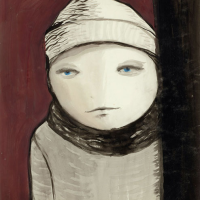48. JOY HESTER

The story of Joy Hesters art and life is bound up in the mythology of Heide, and the personal complexities that underpinned astounding developments in Australian art and homegrown modernity that evolved at Heide around the mid-twentieth century.
John and Sunday Reed purchased the property at Heide in 1934 and quickly opened their home to progressively minded, kindred spirits. Forming a friendship with Sunday in the late 1930s, Joy Hester became a seminal figure of the Heide Circle which included Australian modernist heavyweights such as Sidney Nolan (1917-1992), and Hesters first husband, Albert Tucker (1914-1999). The only woman artist in the Heide vanguard of the 1940s, Hester was a highly original protagonist of the radical avant-garde. In the years following her untimely death in 1960 at just forty years old, Hesters art has achieved something of the recognition it so readily deserves.
An artist of visceral, psychologically intense works, Hester studied at the National Gallery School in Melbourne from 1937-38. She quickly moved beyond the conventional themes and naturalistic style taught there to develop an expressive visual language that took cues from international artists such as Emil Nolde (1867-1956) and Edvard Munch (1863-1944). Her medium of choice was drawing, specifically brush and ink on paper. During this period painting was viewed as the highest form of fine art and drawing was usually reserved for preparatory work, rather than as an artform in its own right. Yet the directness of drawing was perfectly attuned to Hesters style of working quickly to capture passing emotions and sensations.
In 1955, around the time of the present works creation, Hester was living at Avonsleigh on the outskirts of greater Melbourne with her partner Gray Smith, and their two small children. Perhaps reflecting a period of personal contentment, the works of this period are among the more joyful and serene images within her oeuvre. Yet they continue to allude to the mysterious inner life of her subjects. According to Kendrah Morgan, curator of the recent major exhibition of Hesters work at Heide Joy Hester: Remember Me (20 November 2020 14 February 2021), an exploration of motherhood and children had always been natural and unforced subjects for the artist.1 These themes played out in Hesters series of large portraits of children in 1956.
The present work is believed to have been created on the cusp of that series, only a year after Hesters daughter Fern was born in 1954. In it the artist depicts a boy dressed for winter, rendered with sensitivity and tacit undercurrents of isolation and vulnerability.
One of the most notable features of Hesters work is her depiction of eyes, and her skilful utilisation of their expressive possibilities. In earlier series, such as her Faces images created in 1947 when undergoing painful cancer treatment, eyes protrude inward and outward, dominating the composition in many of these powerful and haunting works. In the present work, the eyes are rendered icy blue and inquisitive. He appears to be observing, framed as a silent witness to whatever transpires in the space beyond.
The boy may be a portrait of Peregrine, Hesters son with Gray Smith who was born in 1951, making him around four years old when the present work was created. Or it could be of her eldest child Sweeney, born in 1945, who was left in the care of the John and Sunday Reed when Hester abruptly left Melbourne to undergo life-saving cancer treatment in 1947, when Sweeney was two years old. She depicts Sweeney in the drawing Boy with Pink Arms (Sweeney) 1955 (Newcastle Art Gallery) during the same period as the present work. Yet Hesters style of simplified facial features make definite attributions of subject elusive unless stated.
What the present work does reveal clearly is the artists genius of evoking the emotional and psychological internal world of her subjects with direct line and expressive form. This is seen across her entire oeuvre, whether a tortured face of the late 1940s, or this simple depiction of a young boy, standing more as observer than participant, watching a world around him over which he has little control.
Footnotes
1. Morgan, K. Joy Hester: Remember Me, digital roomsheet, Heide Museum of Modern Art, Victoria, 2020, accessed 12 February 2021: https://www.heide.com.au/exhibitions/joy-hester-remember-me
Marguerite Brown MA (Art Curatorship)